TRIGGER POINTS: Inside the Mission to Stop Mass Shootings in America
My new book is the first ever to tell the story of specialized teams of forensic psychologists, FBI agents, educators, and other experts who are successfully stopping mass shootings. For more about what’s in the book and some early reviews from Lawrence Wright, John Carreyrou, Juliette Kayyem, and Garrett Graff, head over to the HarperCollins page, where you can order a copy from your favorite bookseller.
TRIGGER POINTS is eight years in the making, and I’m excited about its potential to improve public understanding of mass shootings and what more we we can do as a nation to prevent them. I also share a few more details about what’s in the book in this Twitter thread. Thanks for your interest and for reading. -MF
Update, May 12, 2022: coverage of TRIGGER POINTS in the New York Times, the Wall Street Journal, and on NPR’s “Fresh Air.”
“America Under the Gun”: Our award-winning investigation
Proud to share some exciting news: The investigation into mass shootings that I’ve led at Mother Jones has recently been honored with multiple journalism awards: the 2013 Izzy Award, a Society of Professional Journalists award for reporting excellence, and an Online Journalism Award.
![]()
You can read my series of stories from the project and explore all of our data, charts, maps, and additional coverage on MoJo’s special report page.
MediaBugs and the path to more accurate news
A few months back Scott Rosenberg and I filed our final report to the Knight Foundation on the first two years of MediaBugs. Here’s the full top-line summary from it, detailing how our various wins and losses with the project looked from our perspective. (And for much more on our work, check out our various commentary and analysis collected on the MediaBugs blog.)

At the end of 2011 MediaBugs is pivoting from a funded project to a volunteer effort. We’ve racked up some considerable successes and some notable failures. Here’s a recap covering the full two years of project funding:
Successes:
* We built and successfully launched first a Bay Area-based and then a national site for publicly reporting errors in news coverage. These projects represented a public demonstration of how a transparent, neutral, public process for mediating the conversation between journalists and the public can work.
* We surveyed correction practices at media outlets both in our original Bay Area community and then nationally and built a public database of this information.
*We built and maintained a Twitter account with approximately 500 followers to spread awareness of both MediaBugs itself and other issues surrounding corrections practices.
* We maintained our own MediaBugs blog and contributed frequently to the MediaShift Idea Lab blog, where our posts were selected by the 2011 Mirror Awards as a finalist.
* We led a campaign to improve those correction practices in the form of the Report an Error Alliance, collaborating with Craig Silverman to promote the idea that every story page should have a button dedicated to inviting readers to report the mistakes they find. The practice has gained some momentum, with adoption at high-traffic websites like the Washington Post and the Huffington Post.
* We handled 158 error reports with the two largest outcomes being closed: corrected (59) and closed: unresolved (68). Those results included corrections across a range of major media including The New York Times, Wall Street Journal, Washington Post, USA Today, Fox News, CNN, National Public Radio, CBS News, the Associated Press, Reuters, Yahoo News, TechCrunch, and others.
* We took one high-profile error report involving “American Taliban” John Walker Lindh, KQED, and the New York Times, and used it as a kind of teachable moment to publicize some of the problems with existing corrections practices as they collide with digital-era realities. Our extended effort resulted in the Times correcting a story that the subject (through his father) had failed to get corrected for nearly a decade. The full write-up of this story was published on The Atlantic’s website in July, 2011.
* Our surveys of correction practices and related public commentary led many news outlets to revamp and improve their procedures. And many of the specific error-report interactions that led to corrections helped shed light on formerly closed processes in newsrooms, leaving a public record of the interaction between members of the public who brought complaints and journalists who responded to them.
* We partnered with other organizations, including NewsTrust and the Washington News Council, on efforts to correct inaccuracies in news coverage and establish regional MediaBugs organizations. Our software platform became the basis for Carl Malamud’s Legal Bug Tracker project.
Failures:
Our single biggest failure was our inability to persuade any media outlet with a significant profile or wide readership to adopt our service and install our widget on their pages. This limited our reach and made it difficult to spread our ideas. Users had to know about our service already in order to use it, instead of simply finding it in the course of their media consumption.
Our efforts to solve this problem — outreach to friends and colleagues in media outlets; public and private overtures to editors, newsroom managers, and website producers; back-to-the-drawing-board rethinks and revamps of our product and service — occupied much of our time and energy through the two years of the Knight grant.
We did find some success in getting MediaBugs adopted by smaller outlets, local news sites and specialty blogs. In general, it seemed that the people who chose to work with us were those who least needed the service; they were already paying close attention to feedback from their readership. The larger institutions that have the greatest volume of user complaints and the least efficient customer feedback loops were the least likely to take advantage of MediaBugs.
We identified a number of obstacles that stood in our way:
* Large news organizations and their leaders remain unwilling even to consider handing any role in the corrections process to a third party.
* Most newsroom leaders do not believe they have an accuracy problem that needs to be solved. Some feel their existing corrections process is sufficient; others recognize they have a problem with making errors and not correcting them, but do not connect that problem with the decline in public trust in media, which they instead attribute to partisan emotion.
Our other major failure was that we never gathered the sort of active community of error reporters that we hoped to foster. Our efforts included outreach to journalism schools, promotion of MediaBugs at in-person events and industry gatherings (like Hacks and Hackers and SPJ meetups), and postings at established online community sites whose participants might embrace the MediaBugs concept. But our rate of participation and bug-filing remained disappointing.
One explanation we reluctantly came to consider that we hadn’t originally expected: Much of the public sees media-outlet accuracy failures as “not our problem.” The journalists are messing up, they believe, and it’s the journalists’ job to fix things.
A final failure is that we have not, to date, made as much progress as we hoped in transforming journalists’ way of thinking about corrections. We imagined that public demonstration of a more flexible view of errors and corrections would encourage a less secretive, less guilty-minded, more accepting stance in newsrooms. But two years after MediaBugs’ founding, getting news organizations to admit and fix their mistakes in most cases still demands hard work, persistence and often some inside knowledge. Most of the time, it still feels like pushing a boulder up a hill. This needs to change, for the good of the profession and the health of our communities, and MediaBugs intends to keep working on it.
Gabby Giffords and poison politics
In case you missed it, Gabrielle Giffords’ arrival for the State of the Union on Tuesday night was something to behold. In a House chamber so often filled with vapid political theater, the recovering congresswoman’s presence drew a powerful and authentically poignant response—watch it here.
Sadly, the bloodbath she barely survived in Arizona a year ago and its aftermath do not seem to have tempered America’s poisonous politics at all: Just hours before Giffords got a standing ovation in Congress and embraced President Obama, some unknown stalker was targeting four female Democratic lawmakers in Missouri’s Capitol with rifle crosshairs. Details are in my piece from last night over at MoJo.
MoJo working
 Why so quiet here on the blog the last couple months? As many of you know, in September I started a new gig at Mother Jones. That’s keeping me pretty busy these days, but I’ll continue to post here from time to time. You can also follow my work over there. Some recent pieces include: my further reporting on the strangely inconsistent accounts of how the US military killed Osama bin Laden; how the hacks behind Andrew Breitbart’s Big Government website got caught making a big blunder on climate change and wouldn’t cop to it; and how Breitbart and other right-wingers apparently became obsessed with raunchy jokes about Occupy Wall Street. I also edited and produced multimedia for a major investigative project about Texas criminal justice gone horribly wrong. The story, “No Country for Innocent Men,” was written by the great Beth Schwartzapfel, and you should go read it now. (Also watch the video, read the prisoners’ letters, and peruse the interactive map.) It is emotionally searing and deeply informative.
Why so quiet here on the blog the last couple months? As many of you know, in September I started a new gig at Mother Jones. That’s keeping me pretty busy these days, but I’ll continue to post here from time to time. You can also follow my work over there. Some recent pieces include: my further reporting on the strangely inconsistent accounts of how the US military killed Osama bin Laden; how the hacks behind Andrew Breitbart’s Big Government website got caught making a big blunder on climate change and wouldn’t cop to it; and how Breitbart and other right-wingers apparently became obsessed with raunchy jokes about Occupy Wall Street. I also edited and produced multimedia for a major investigative project about Texas criminal justice gone horribly wrong. The story, “No Country for Innocent Men,” was written by the great Beth Schwartzapfel, and you should go read it now. (Also watch the video, read the prisoners’ letters, and peruse the interactive map.) It is emotionally searing and deeply informative.
September also marked the end of the two-year Knight News Challenge grant that funded MediaBugs. The error-reporting service remains fully operational; my project partner Scott Rosenberg (who is now the executive editor of Grist) and I are continuing to run it on a volunteer basis. We had a number of great successes with MediaBugs in the first two years of the project — as well as some frustrations and failures. In January we’ll detail those in a report that we’re planning to publish on the MediaBugs blog. Transparency is a cornerstone of the project, and we believe there is value, both for our media colleagues and the news-consuming public, in sharing what we’ve learned. I’ll also re-post the report here.
As always, thanks for reading — and more to come soon, both here and over at MoJo!
Return to Medicine Bow
Two summers ago I posted about the mix of beauty and devastation in Wyoming’s Medicine Bow National Forest. It was a similar story upon returning this August: this year’s heavy rains and enduring snow packs meant another incredible burst of wildflowers. (As well as some tragic flooding.)
Sadly, the fallout from climate change also continues here. Because winter temperatures are no longer as cold, the bark beetle population continues to survive and thrive, killing off the pine forests. This was a typical sight in the vicinity of the Sugarloaf recreation area:
Bonus shot: Train tracks in Laramie.

See photos from the trip in 2009 and read more about climate change and the region’s bark beetle epidemic here.
Conflicting tales of killing bin Laden
[This post has been revised and expanded several times since initial publication; see updates below.]
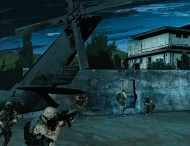 You don’t have to be a conspiracy theorist to be still scratching your head about the end of Osama bin Laden. Between the Obama administration and major US media, the story of the Navy SEALs’ mission in Abbottabad has never seemed quite straight, tilting toward the political or fantastical more than the cohesive. In some respects that’s unsurprising for one of the most important and highly classified military missions in modern memory — one whose outcome, many would argue, is all that really matters. But as America prepares to reflect on the tenth anniversary of 9/11, it’s worth considering how the tales have been told, and where history begins to bleed into mythology. After several months of revised accounts and inside scoops, we still have a conspicuously muddled picture of bin Laden’s killing.
You don’t have to be a conspiracy theorist to be still scratching your head about the end of Osama bin Laden. Between the Obama administration and major US media, the story of the Navy SEALs’ mission in Abbottabad has never seemed quite straight, tilting toward the political or fantastical more than the cohesive. In some respects that’s unsurprising for one of the most important and highly classified military missions in modern memory — one whose outcome, many would argue, is all that really matters. But as America prepares to reflect on the tenth anniversary of 9/11, it’s worth considering how the tales have been told, and where history begins to bleed into mythology. After several months of revised accounts and inside scoops, we still have a conspicuously muddled picture of bin Laden’s killing.
Lots of praise flowed earlier this month for Nicholas Schmidle’s riveting account in the New Yorker of the SEALs’ raid on bin Laden’s compound. It added many vivid details to what was publicly known about the killing of America’s arch-nemesis that fateful morning in early May. But Schmidle’s exquisitely crafted reconstruction also contradicted previous reporting elsewhere, and sparked some intriguing questions of its own.
It underscored what we still don’t really know about the operation. Schmidle’s depiction of the tense scene in the White House Situation Room, as President Obama and his top advisers monitored the action with the help of a military drone, included a notable refutation. The SEALs converged at the ground floor of bin Laden’s house and began to enter, Schmidle reported, but:
What happened next is not precisely clear. “I can tell you that there was a time period of almost twenty to twenty-five minutes where we really didn’t know just exactly what was going on,” [CIA chief Leon] Panetta said later, on “PBS NewsHour.” Until this moment, the operation had been monitored by dozens of defense, intelligence, and Administration officials watching the drone’s video feed. The SEALs were not wearing helmet cams, contrary to a widely cited report by CBS.
Schmidle was referring to a May 12 story by veteran CBS News national security correspondent David Martin headlined, “SEAL helmet cams recorded entire bin Laden raid.”
The contradiction has big implications. Martin’s own story was in part a response to the famously mutating account from the Obama White House in the days following the mission. The administration had attributed its multiple revisions to “the fog of war” after backtracking from claims that bin Laden had engaged the SEALs in a firefight and used his wife as a human shield. Martin’s piece stated he was putting forth “a new picture of what really happened” in Abbottabad; he reported that “the 40 minutes it took to kill bin Laden and scoop his archives into garbage bags were all recorded by tiny helmet cameras worn by each of the 25 SEALs. Officials reviewing those videos are still reconstructing a more accurate version of what happened.”
Such footage obviously could go a long way toward a precise account. According to Schmidle’s New Yorker piece, though, it doesn’t exist.
There are other glaring discrepancies between the New Yorker and CBS News reports concerning the climax of the raid. In Schmidle’s version, the encounter involved two of bin Laden’s wives, and one SEAL firing the kill shots:
The Americans hurried toward the bedroom door. The first SEAL pushed it open. Two of bin Laden’s wives had placed themselves in front of him. Amal al-Fatah, bin Laden’s fifth wife, was screaming in Arabic. She motioned as if she were going to charge; the SEAL lowered his sights and shot her once, in the calf. Fearing that one or both women were wearing suicide jackets, he stepped forward, wrapped them in a bear hug, and drove them aside….
A second SEAL stepped into the room and trained the infrared laser of his M4 on bin Laden’s chest. The Al Qaeda chief, who was wearing a tan shalwar kameez and a prayer cap on his head, froze; he was unarmed…. Nine years, seven months, and twenty days after September 11th, an American was a trigger pull from ending bin Laden’s life. The first round, a 5.56-mm. bullet, struck bin Laden in the chest. As he fell backward, the SEAL fired a second round into his head, just above his left eye.
But in Martin’s version, the encounter involved bin Laden’s “daughters” as well as one of his wives — and not one, but two SEALs firing the kill shots:
The SEALs first saw bin Laden when he came out on the third floor landing. They fired, but missed. He retreated to his bedroom, and the first SEAL through the door grabbed bin Laden’s daughters and pulled them aside.
When the second SEAL entered, bin Laden’s wife rushed forward at him — or perhaps was pushed by bin Laden. The SEAL shoved her aside and shot bin Laden in the chest. A third seal shot him in the head.
What’s going on here? Martin’s piece for CBS aired nearly two weeks after the raid; presumably the US government had its story straight by then. (The Guardian’s roundup of White House revisions linked above was published on May 4.) Martin provides scant information about his sourcing. If his piece has turned out to contain inaccuracies, to date CBS News has given no indication.
It is also possible that Schmidle’s piece contains inaccuracies, although it is more deeply reported and goes further in describing its sources. They include Obama’s chief counterterrorism adviser John O. Brennan, deputy national security adviser Ben Rhodes, and perhaps most significantly, “a special-operations officer deeply familiar with the bin Laden raid.”
Still, Schmidle wasn’t able to interview any of the Navy SEALs directly involved in the mission, despite that his piece seemed to suggest he had. Instead, Schmidle told the Washington Post’s Paul Farhi, he relied on the accounts of others who had debriefed the men.
Schmidle wrote conspicuously of the SEALs’ perspective during the raid: “None of them had any previous knowledge of the house’s floor plan, and they were further jostled by the awareness that they were possibly minutes away from ending the costliest manhunt in American history; as a result, some of their recollections — on which this account is based — may be imprecise and, thus, subject to dispute.”
From fraught US-Pakistan relations to conspiracy theories to partisan politics, it’s an understatement to say that there is keen interest in knowing exactly how the killing of bin Laden went down. Faulty reporting may be to blame for standing in the way. Alternatively, the mind doesn’t require much bending to imagine why military, CIA or White House officials might have been happy at various turns to help muddle the story. A certain degree of imprecision or misdirection can serve the side of secrecy. Perhaps at a time when the White House declined, amid much clamor, to release photos of bin Laden’s corpse, it was useful to let the world know that it also had video footage of the whole operation. Perhaps at some later point it was useful to quash the idea that the US government had lots of raw footage with which it might address questions about the circumstances and legality of bin Laden’s killing.
Whatever the case, one of two stories from major American media outlets is flat-out wrong on a significant piece of information about the raid. (As well as on some other details, it seems.) It may be that a precise account of the historic military mission will elude us for a long time, just as its target so famously did.
How many SEALs? (Update, Aug. 4)
Looking back over the CBS News piece again, I spotted another discrepancy: Martin reported that 25 SEALs stormed bin Laden’s compound; Schmidle’s New Yorker piece says there were 23 SEALs directly in on the raid. (Plus a Pakistani-American translator and a now legendary Belgian Malinois.)
Also, it’s worth noting how central the helmet cam information was to Martin’s story; the video version of it opened with a “CBS news animation” showing them:
I’ve also now filed an error report about this at MediaBugs, seeking a response from CBS News. I don’t have enough information to know whether their story is inaccurate, but it seems fair to say that the overall picture here suggests the onus is on CBS to corroborate their story.
Lack of disclosure (Update 2, Aug. 4)
In a guest post at Registan.net, Georgetown professor C. Christine Fair raises some provocative questions about Schmidle’s New Yorker piece, including about its sourcing. She is not the only one rebuking the magazine for failing to disclose clearly that Schmidle did not talk to any of the SEALs who raided the bin Laden compound. (That lack of disclosure apparently prompted an error and correction on NPR’s “Morning Edition.”) Fair wonders about how certain details in the story, and the fact that Schmidle’s father is the deputy commander of the US Cyber Command, might play across the Muslim world. Though I don’t necessarily share her conclusions, the post is interesting and worth a read.
“An administration puff piece” (Update 3, Aug. 10)
Marcy Wheeler has a rundown on Schmidle’s sourcing. She suggests that Obama senior advisers Brennan and Rhodes may have served as anonymous sources for the piece as well as named ones. (Not an uncommon practice in the journalism field, in my experience.) Thus, she argues, Schmidle’s piece deserves greater scrutiny in light of the “war on leaks” conducted under Obama. “This story is so thinly veiled an administration puff piece,” Wheeler says, “it ought to attract as much attention for the sheer hypocrisy about secrecy it demonstrates as it will for the heroism such hypocrisy attempts to portray.”
A Hollywood conspiracy (Update 4, Aug. 11)
Rep. Peter King, the Republican chairman of the House Homeland Security Committee, has called for an investigation into alleged collaboration between the Obama administration and filmmakers Kathryn Bigelow and Mark Boal (of “The Hurt Locker” fame) for a forthcoming movie about the bin Laden takedown. Reportedly due for release in October 2012, just before the next presidential election, the movie project “belies a desire of transparency in favor of a cinematographic view of history,” according to King. The White House says King’s take is “ridiculous.” The story here seems to be opposition party politics layered on top of presidential politics layered on top of a Hollywood production — with the finer facts of bin Laden’s demise buried somewhere beneath.
Seeking clarification (Update 5, Aug. 15)
I’ve reached out to Nicholas Schmidle by email asking if he can offer any additional information regarding the helmet cam issue. (His New Yorker piece says nothing about his sourcing on that particular point.) I’ve also contacted CBS News about it and am in the process of looking for a more direct way to reach David Martin.
More details that don’t add up (Update 6, Aug. 26)
For more on this story, read my piece over at Mother Jones, which includes further examples of conflicting details from news reports on the bin Laden mission.
The case of the New York Times’ terror error
 As the 10th anniversary of 9/11 approaches, it isn’t hard to recall the politically fraught case of the 20-year-old bearded kid captured by US soldiers in Afghanistan in late 2001. But think the media got the whole story right on the so-called American Taliban?
As the 10th anniversary of 9/11 approaches, it isn’t hard to recall the politically fraught case of the 20-year-old bearded kid captured by US soldiers in Afghanistan in late 2001. But think the media got the whole story right on the so-called American Taliban?
Think again: Nearly a decade later, a rather extraordinary meltdown occurred during a recent San Francisco radio show focused on the case of John Walker Lindh. It happened thanks to 14 erroneous words printed in the New York Times in July 2002. My MediaBugs partner Scott Rosenberg and I just published a long piece in The Atlantic that traces the tale and explains its profound implications for news accuracy in the digital age. Here’s how it begins:
***
It is hard to describe the interview that took place on KQED’s Forum show on May 25, 2011, as anything other than a train wreck.
Osama bin Laden was dead, and Frank Lindh — father of John Walker Lindh, the “American Taliban” — had been invited on to discuss a New York Times op-ed piece he’d just published about his son’s 20-year prison sentence. The moment host Dave Iverson completed his introduction about the politically and emotionally charged case, Lindh cut in: “Can I add a really important correction to what you just said?”
Iverson had just described John Walker Lindh’s 2002 guilty plea as “one count of providing services to a terrorist organization.” That, Frank Lindh said, was simply wrong.
Yes, his son had pled guilty to providing services to the Taliban, in whose army he had enlisted. Doing so was a crime because the Taliban government was under U.S. economic sanctions for harboring Al Qaeda. But the Taliban was not (and has never been) classified by the U.S. government as a terrorist organization itself.
This distinction might seem picayune. But it cut to the heart of the disagreement between Americans who have viewed John Walker Lindh as a traitor and a terrorist and those, like his father, who believe he was a fervent Muslim who never intended to take up arms against his own country.
 That morning, the clash over this one fact set host and guest on a collision course for the remainder of the 30-minute interview. The next day, KQED ran a half-hour Forum segment apologizing for the mess and picking over its own mistakes.
That morning, the clash over this one fact set host and guest on a collision course for the remainder of the 30-minute interview. The next day, KQED ran a half-hour Forum segment apologizing for the mess and picking over its own mistakes.
KQED’s on-air fiasco didn’t happen randomly or spontaneously. The collision was set in motion nine years before by 14 erroneous words in the New York Times.
This is the story of how that error was made, why it mattered, why it hasn’t been properly corrected to this day — and what lessons it offers about how newsroom traditions of verification and correction must evolve in the digital age.
***
Read the whole thing here in The Atlantic. We reexamined the complicated Lindh case and conducted interviews with Frank Lindh, reporters and editors at the New York Times and KQED, and experts on media accuracy to get to the bottom of what turned out to be a fascinating case study.
Bonus link: Apparently the New York Times is not the only major news outlet with a Lindh error lurking in its digital archive.
“The White House wants to get him”
I’m still stunned from reading this story on the front page of today’s New York Times. Officials in George W. Bush’s White House, James Risen reports, directed the Central Intelligence Agency to dig up damaging personal information on Juan Cole, an American university professor, Middle East expert and zealous critic of the Iraq war. The CIA’s illegal spying against Cole apparently took place in 2006. At the time I was one of his editors at Salon, where he contributed a regular column.
Risen reports on revelations from a top counterterrorism official, Glenn L. Carle, who was deeply troubled by Bush administration plotting against Cole:
In 2005, after a long career in the C.I.A.’s clandestine service, Mr. Carle was working as a counterterrorism expert at the National Intelligence Council, a small organization that drafts assessments of critical issues drawn from reports by analysts throughout the intelligence community. The council was overseen by the newly created Office of the Director of National Intelligence. Mr. Carle said that sometime that year, he was approached by his supervisor, David Low, about Professor Cole. Mr. Low and Mr. Carle have starkly different recollections of what happened. According to Mr. Carle, Mr. Low returned from a White House meeting one day and inquired who Juan Cole was, making clear that he wanted Mr. Carle to gather information on him. Mr. Carle recalled his boss saying, “The White House wants to get him.”
“‘What do you think we might know about him, or could find out that could discredit him?'” Mr. Low continued, according to Mr. Carle.
Mr. Carle said that he warned that it would be illegal to spy on Americans and refused to get involved, but that Mr. Low seemed to ignore him.
“But what might we know about him?” he said Mr. Low asked. “Does he drink? What are his views? Is he married?”
Mr. Carle said that he responded, “We don’t do those sorts of things,” but that Mr. Low appeared undeterred. “I was intensely disturbed by this,” Mr. Carle said.
The next day Carle came across a memo on Cole bound for the White House. The supervisor to whom Carle took it marked it up with a red pen and told Carle that he’d take care of it. But Cole remained a target.
Several months after the initial incident, Mr. Carle said, a colleague on the National Intelligence Council asked him to look at an e-mail he had just received from a C.I.A. analyst. The analyst was seeking advice about an assignment from the executive assistant to the spy agency’s deputy director for intelligence, John A. Kringen, directing the analyst to collect information on Professor Cole.
Mr. Carle said his colleague, whom he declined to identify, was puzzled by the e-mail. Mr. Carle, though, said he tracked Mr. Kringen’s assistant down in the C.I.A. cafeteria.
“Have you read his stuff?” Mr. Carle recalled the assistant saying about Professor Cole. “He’s really hostile to the administration.”
The assistant, whom Mr. Carle declined to identify, refused to say who was behind the order. Mr. Carle said he warned that he would go to the agency’s inspector general or general counsel if Mr. Kringen did not stop the inquiry.
Notable, too, in the Times story are the equivocal denials from three higher-ups (including John Negroponte, then the director of national intelligence), all of whom seem to have lost their faculty for clear memory.
Today at his Informed Comment blog, Cole himself weighs in. He notes that officials from the intelligence community and Bush administration were in fact interested in his expertise on terrorism and the Middle East, some of whom attended talks he gave. “Apparently one of the purposes of spying on me to discredit me, from the point of view of the Bush White House, was ironically to discourage Washington think tanks from inviting me to speak to the analysts, not only of the CIA but also the State Department Intelligence and Research and other officials concerned with counter-terrorism and with Iraq.”
Cole describes Carle’s revelations as “a visceral shock,” concluding:
What alarms me most of all in the nakedly illegal deployment of the CIA against an academic for the explicit purpose of destroying his reputation for political purposes is that I know I am a relatively small fish and it seems to me rather likely that I was not the only target of the baleful team at the White House. After the Valerie Plame affair, it seemed clear that there was nothing those people wouldn’t stoop to. You wonder how many critics were effectively “destroyed.” It is sad that a politics of personal destruction was the response by the Bush White House to an attempt of a citizen to reason in public about a matter of great public interest. They have brought great shame upon the traditions of the White House, which go back to George Washington, Thomas Jefferson, and James Madison, who had hoped that checks and balances would forestall such abuses of power.
In the summer of 2008, with Barack Obama and the Democrats poised to take control of Washington, another Salon contributor, Tim Shorrock, reported on plans brewing on Capitol Hill for a potentially major investigation of abuses. The idea was “to have Congress appoint an investigative body to discover the full extent of what the Bush White House did in the war on terror to undermine the Constitution and U.S. and international laws. The goal would be to implement government reforms aimed at preventing future abuses — and perhaps to bring accountability for wrongdoing by Bush officials.”
Some might say that a catastrophic economic meltdown, among other daunting challenges, got in the way. But despite the inaction, others might say that defending America’s constitutional foundation against internal rot is as important as anything.
UPDATED 6/18/11: A Boston Globe editorial calls for a congressional investigation, suggesting that the alleged Bush-CIA shenanigans “should be treated as the possible relapse of a bad disease.” (Hat tip: @TheByliner.)
John Yoo’s faulty Bin Laden conspiracy theory
John Yoo is someone who knows how to push an argument. At the U.S. Justice Department he designed rationales for the most controversial policies of the Bush-Cheney “war on terror,” and since then he has promoted right-wing political views in the opinion pages of the Wall Street Journal. Yoo must also know that an argument, however unyielding, quickly goes limp when it gets basic facts wrong.
If so, he hasn’t bothered to address a key problem with his recent Op-Ed trashing President Obama for the killing of Osama bin Laden. His misrepresentation of the CIA’s role, flagged in a MediaBugs error report, undermines Yoo’s most audacious critique of the president.
What was hailed across the press and party lines as Obama’s “gutsy” call to send in the Navy Seals, Yoo regarded as a botched opportunity. He suggested that the U.S. might have taken bin Laden alive. “If true, one of the most valuable intelligence opportunities since the beginning of the war has slipped through our hands,” Yoo wrote in the Journal.
That was just part of how he reiterated the case for the Bush administration’s brutal interrogations of terrorist suspects. Yoo further argued that Obama wanted bin Laden not dead or alive, but just dead — because taking him prisoner would have required Obama “to hold and interrogate bin Laden at Guantanamo Bay, something that has given this president allergic reactions bordering on a seizure.”
Here’s the problem: Yoo’s argument hangs on a faulty summation of the intelligence trail that brought the Navy Seals to Abbottabad. From Yoo’s perspective, as the U.S. closed in on the compound “the CIA became certain that the al Qaeda leader was hiding inside.”
That doesn’t square with planning and operational details made public by top Obama officials and the president himself. As many news outlets have reported, Obama had to calculate his risky decision based on uncertain evidence of bin Laden’s whereabouts. According to CIA director Leon Panetta, analysts were only 60 to 80 percent confident bin Laden would be found in the compound. “We never had direct evidence that he in fact had ever been there or was located there,” Panetta said. National Security Advisor Tom Donilon said Obama made his move based on “what was probably a 50-50 chance that Osama bin Laden was there.” The president himself said on “60 Minutes” that “there was no direct evidence” of bin Laden’s presence.
If Yoo and the editors of the Wall Street Journal know something about the bin Laden operation the rest of don’t, they should share it. Otherwise, they should correct the record.
In a recent conversation about news accuracy, a senior editor at the New York Times told me that its opinion writers tend to get more leeway than its news reporters do when it comes to drawing context. Still, he said that when an opinion writer has clearly gotten a fact wrong “you have to correct it.”
We agree. The question is, does the Wall Street Journal? We may not get an answer to that; thus far the Journal has been unresponsive to inquiries about Yoo’s piece, and its newsroom has proven inaccessible on such matters in prior cases.
It’s unsurprising to see Yoo argue for the notorious interrogation policies he helped craft. (Or for more credit for bin Laden’s demise to go to the president he worked for.) But his implication that Obama — armed with full-proof intelligence — intended from the get-go to bury bin Laden at sea just so he wouldn’t have to decide whether to waterboard him looks foolish in the face of widely reported facts. Meanwhile, the Times has since reported that the White House had two teams of specialists ready for action during the mission: “One to bury Bin Laden if he was killed, and a second composed of lawyers, interrogators and translators in case he was captured alive.”
As of this writing, MediaBugs’ multiple emails to Yoo and the Wall Street Journal have gotten no response and Yoo’s piece remains as it was first published.
[Cross-posted from the MediaBugs blog.]
UPDATED: A couple of interesting comments over at the MediaBugs blog.
UPDATED, 5/16/11: In the Washington Post today, Greg Sargent reports about a “private letter” from Leon Panetta to John McCain strongly making the case that interrogation by torture was not instrumental in tracking down Osama bin Laden.
The Panetta letter reveals further problems with Yoo’s piece, in which Yoo claimed: “CIA interrogators gathered the initial information that ultimately led to bin Laden’s death. The United States located al Qaeda’s leader by learning the identity of a trusted courier from the tough interrogations of Khalid Sheikh Mohammed, the architect of the 9/11 attacks, and his successor, Abu Faraj al-Libi.”
But according to Panetta’s letter: “We first learned about the facilitator/courier’s nom de guerre from a detainee not in CIA custody in 2002.”
Panetta continued: “It is also important to note that some detainees who were subjected to enhanced interrogation techniques attempted to provide false or misleading information about the facilitator/courier. … In the end, no detainee in CIA custody revealed the facilitator/courier’s full true name or specific whereabouts. This information was discovered through other intelligence means.”
UPDATED, 5/23/11: And now Yoo’s polemic in the Wall Street Journal has been further discredited by reporting in… the Wall Street Journal. In March, according to the Journal, Defense Secretary Bob Gates also felt explicit uncertainty about bin Laden’s presence in Abbottabad (emphasis mine):
The B-2 plan had many supporters, particularly among military brass. A bombing would provide certainty that the compound’s residents would be killed, and it posed less risk to U.S. personnel. At the time, Mr. Gates, the defense secretary, was skeptical of the intelligence case that bin Laden was at the compound.
As late as April 28 — just three days before the raid — Gates still worried about it. Obama convened his top national security advisers in the White House Situation Room. “Only at that meeting,” reports the Journal, “did Mr. Gates come around to fully endorsing the operation, because of his skepticism of the intelligence indicating bin Laden was there.”
The case for releasing the Bin Laden photo
[Post updated below through May 10.]
 In my view there’s a clear and compelling reason why the United States should release an image of Osama bin Laden’s corpse. It has little to do with nutty conspiracy theories, which were a consideration in the White House decision not to “spike the football.” For most of the world already, the fact of bin Laden’s killing is indeed unimpeachable. (One reason why President Obama deserves huge credit for what many view as his very “gutsy” call on the Navy Seals operation.) Even if bin Laden’s body had been displayed for a month in Mecca prior to disposal, there would still be crazies in the Arab world and beyond convinced of some grand, evil scheme. (“A fraudulent corpse delivered by the Mossad, CIA and George Soros!” Etc.)
In my view there’s a clear and compelling reason why the United States should release an image of Osama bin Laden’s corpse. It has little to do with nutty conspiracy theories, which were a consideration in the White House decision not to “spike the football.” For most of the world already, the fact of bin Laden’s killing is indeed unimpeachable. (One reason why President Obama deserves huge credit for what many view as his very “gutsy” call on the Navy Seals operation.) Even if bin Laden’s body had been displayed for a month in Mecca prior to disposal, there would still be crazies in the Arab world and beyond convinced of some grand, evil scheme. (“A fraudulent corpse delivered by the Mossad, CIA and George Soros!” Etc.)
More importantly the White House is wary of inflaming Muslim opinion against the U.S. But from Abu Ghraib to Guantanamo to the Koran-burning pastor in Florida to U.S. military atrocities in Afghanistan, the case of inflammation is already chronic. It’s a problem not easily controlled, let alone alleviated. I’m not sure I see how visual evidence of bin Laden’s death, even if pretty gruesome, adds significantly to it.
Proof isn’t the key point. (Nor is jingoism.) The reason to release the photo is the tremendous value of destroying, with vivid finality, bin Laden’s potent mythological image. Yes, the devotees of his jihad will promote the whole martyr thing. But they’re already doing that anyway.
Those who’ve studied bin Laden’s journey know how incredibly important his carefully tended cult of personality has been to his cause. Lawrence Wright documented this exhaustively in his masterful tome, The Looming Tower: Al Qaeda and the Road to 9/11. In the decade since 9/11, bin Laden’s successful evasion of the mightiest military in the world fed his symbolic power and the inspiration of his followers. It gave him a kind of metaphysical strength and credibility far greater than any cries of martyrdom now can. If his killing at the hands of the U.S. military was indeed a “decapitation” of Al Qaeda, then once that killing is in clear view bin Laden’s death cult also loses its heart.
No doubt a gruesome image would stir strong emotions around the world. But anger at the U.S. would be affected minimally and ephemerally, I think, discounting those already stewing in the radical margins. The narrative benefits of the publicity would be greater. Especially, as Steve Clemons suggests, if the White House were to release images simultaneously of bin Laden’s “respectful” burial at sea.
UPDATED: Other arguments in favor of putting out the photos from Steve Clemons and Jack Shafer.
UPDATED 5/5/11: An opinion piece today from the International Herald Tribune, “The Death of an Icon,” goes to the heart of my thinking on this issue. “Osama bin Laden, the visual icon of terrorism in our fear-driven age, is gone,” writes Columbia history professor Richard Bulliet. “No one can replace him.”
He explains in detail why bin Laden “was unquestionably the master recruiter” for Al Qaeda:
Compared with the two-dozen jihadist videotapes I analyzed in connection with police investigations in 2002-2003, Bin Laden’s propaganda stands out. Not only does it present a plausible argument for jihad against the West, but his visual presence and calm voiceovers convey an aura of authority and leadership even though his name is never mentioned.
His screen presence also far outshadows that of other jihadist leaders. Where they are strident, or ranting, or dull, he is calm and articulate. Where they come across as one-note preachers or pedantic classroom teachers, he appears as a fully formed individual. Comfortable in the mosque, on the battlefield, at the training camp, or in a poetry recital.
One cannot mourn the death of a man who planned or inspired so many atrocities. But we should recognize that his bigger-than-life iconic presence was the heart and soul of jihadist Islam.
Read the whole piece — essential analysis on the meaning and impact of bin Laden’s end.
Also see Deborah Copaken Cogan, who suggests that “to sanitize photos is to distort history.”
 UPDATED 5/10/11: The Associated Press is pursuing the bin Laden images with a Freedom of Information Act request. The AP cites Obama’s campaign vow to make his administration “the most transparent government in U.S. history” and points to the muddled narrative surrounding bin Laden’s killing, which has been revised multiple times by the White House. Says AP senior editor Michael Oreskes about the visual evidence of bin Laden’s death: “This information is important for the historical record.”
UPDATED 5/10/11: The Associated Press is pursuing the bin Laden images with a Freedom of Information Act request. The AP cites Obama’s campaign vow to make his administration “the most transparent government in U.S. history” and points to the muddled narrative surrounding bin Laden’s killing, which has been revised multiple times by the White House. Says AP senior editor Michael Oreskes about the visual evidence of bin Laden’s death: “This information is important for the historical record.”
Bookending Bin Laden
MoJo’s Michael Mechanic has pulled together how eight newspapers captured the defining moments of Osama bin Laden’s mortal entanglement with America. From the Gray Lady to the tabloids, it’s interesting to look through these juxtaposed front pages and reflect on all that transpired in the decade between:
(The Examiner’s awkward ad on May 2 is also evocative of historic changes — those roiling the news biz. Though I’m not totally sure about the tabloids, until a couple years ago the front pages were sacrosanct.) Check out the rest of the images here.
 Leave a Comment
Leave a Comment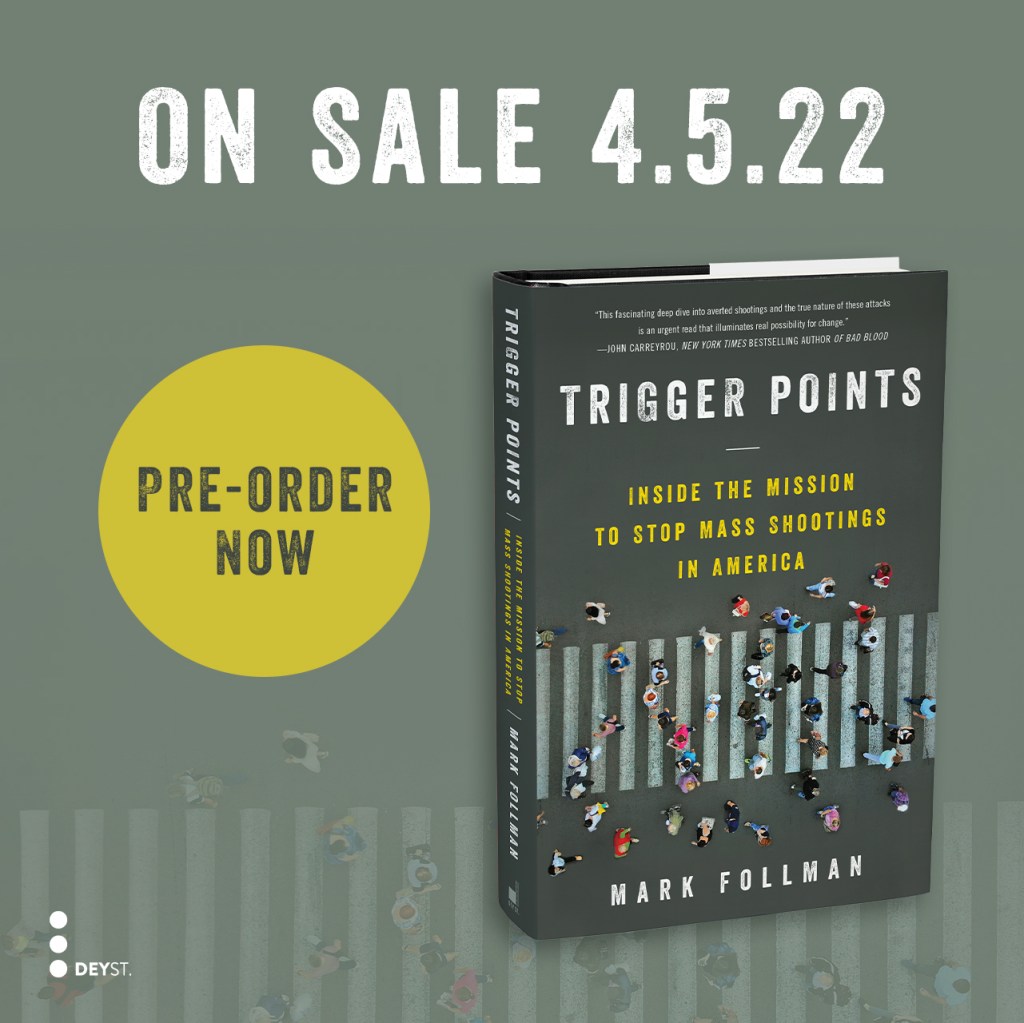







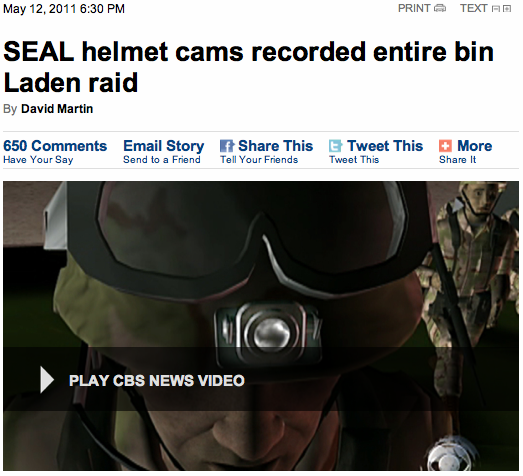

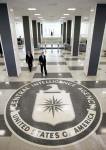




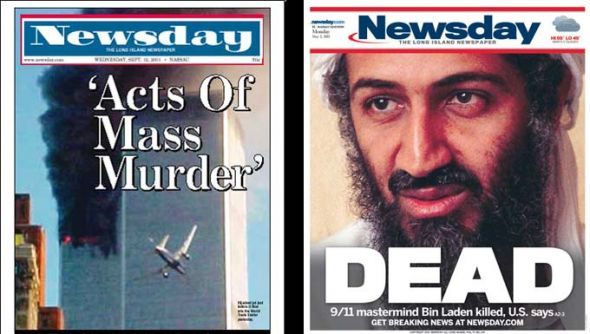


You must be logged in to post a comment.